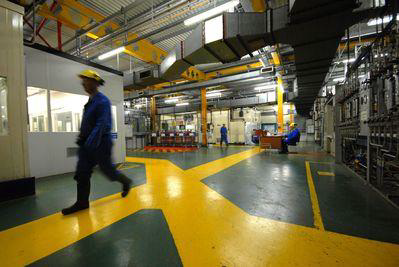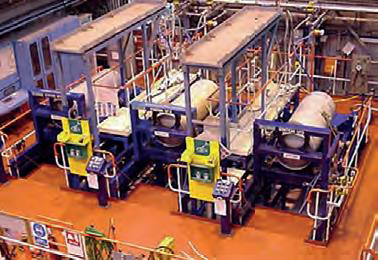Background
Westinghouse Electric Company continues to lead the way in the treatment of uranium-bearing residues, using several large-scale global facilities with a diverse range of capabilities to process hundreds of residue types.
As a fuel manufacturer, Westinghouse has the ability to recycle uranium and return it to the fuel cycle.
Description
Westinghouse has several facilities globally with skilled and experienced operators to process various forms of uranium-bearing residues (e.g., UF6, UO3, UO2, ash, sludge, soft materials and oil-contaminated residues).
We have access to technical support from laboratory experts, enabling Westinghouse to develop tailor-made processing systems with capabilities focused purely on transforming uranium-bearing residual material into a useable product.
Varying volumes of material, from a few kilograms to many tons, can be handled. We also offer pre-processing services, such as sampling, material sorting, size reduction, de-canning and re-drumming both at Westinghouse sites and at customer facilities as part of the customized service.

Residue Treatment Plant at Springfield’s
Enriched Uranium Residues:
Westinghouse can process uranium-bearing materials up to 100 percent enrichment. For material up to 5 percent enrichment, residues and scrap materials are processed to U3O8 and/or UO2 through furnace treatment, and contaminated materials can undergo recovery by nitric acid dissolution, solvent extraction and precipitation to output a clean UO2 product. The recovered uranium can then be returned to the fuel cycle. For materials with enrichment greater than 5 percent, specialist solutions are available.
For dirty residues (e.g. contaminated uranium-bearing materials, such as gadolinia) and scrap materials, Westinghouse experts will determine through analysis and testing the best route for recovery to meet our customer's needs.
In some cases where recovery back into the fuel cycle is impractical, we can convert uranic residues into a safe and stable form for storage and can provide size reduction, helping to reduce long term storage costs.
Natural and Depleted Uranium Recovery:
Westinghouse has the ability to process high volumes of natural and depleted uranium residues for immediate return to the fuel cycle or conversion to UO3 for storage. Uranic liquids, powders, metal, slurry, sludge or bulk feed material can be processed, and nominally at enrichments up to 1 percent. Enrichments up to 1.4 percent can be considered on a case-by-case basis.
Fuel De-fabrication:
Westinghouse’s facilities are able to take unused and un-irradiated fuel from reactor sites and unload pellets, recover the uranium and return it to the manufacturing process for the use in customers’ new fuel fabrication, or we can make the material available for sale to the market (e.g., Feed and SWU).
Contaminated Soft Residues:
Westinghouse has developed multiple innovative processes which remove uranium from contaminated soft residues (e.g., cloth, paper, plastics and rubber) and filters from operating plants as well as legacy materials.
- A nitric aid wash process involves preparing the soft residue by shredding, bagging and washing it with nitric acid to recover the uranium, following rinsing and drying.
- A pyrolysis process uses leaching to extract uranium from contaminated soft materials.
The uranium from both of these processes is recovered to the fuel cycle, and the resultant waste is disposed of to a waste facility.

UF6 cylinder washing facility
Cylinder Washing:
Our fuel fabrication plants can process both 30B and 48Y cylinders to remove UF6 heels. The cylinder is placed on a specific rig for quenching and washing and is rinsed with water before drying. These rigs can also be used for hydraulic pressure testing of repaired cylinders. We also offer cylinder maintenance and re-validation services.
Westinghouse has a stand-alone facility to clean non-standard cylinders holding a ‘heel’ of UF6. The cylinders can then be cut up, decontaminated and either recycled or disposed of to a waste facility. This facility can process cylinders up to a maximum size of 30B type and can take enriched material up to 5 percent.
Decontamination:
Our Natural Decontamination Facility can sort and reduce the size of material, as well as dismantle and cut larger items containing natural uranium. This facility uses an acid washing/pickling technique and is suitable for materials such as metal, wood, rubble, etc. The goal is to clean the material to disposal levels for low level waste storage or even free release levels. This same service is also available for material contaminated with enriched material. Material with enrichments up to 5 percent can be readily processed, with enrichments greater than this processed under special controls. This facility uses citric acid, but can be converted to nitric acid it required.
Benefits
The financial and regulatory impact of storing uranic residues can be significant. While interim storage of residues may seem like a low-cost option in the short term, it means ongoing costs for facilities, manpower and equipment, without a permanent solution. Also, regulations for sending uranic materials to disposal or long-term storage facilities can differ depending on the type of material. This often results in needing to develop residue-dependent storage solutions to satisfy regulatory requirements.
Westinghouse is able to assess your specific situation, with the ultimate goal of recycling the uranium contained in the residues for use in the fuel cycle. This enables customers to reduce or remove uranium-bearing legacy materials from their facilities.
Deliverables
Westinghouse has a dedicated residues team who work with customers and regulators to assess material, conduct trials and develop processing options that will best suit our customer’s needs.
A project manager will be assigned to establish project-specific requirements, working with our technical experts to develop a cost-effective solution to process the uranium-bearing material.
Experience
With extensive experience in processing our own residues and legacy residues, Westinghouse understands issues regarding legacy uranic material.
Westinghouse has characterized and processed more than 50,000 residue drums comprising more than 1,000 different residue types generated over 60 years of nuclear fuel research and manufacturing processes.



